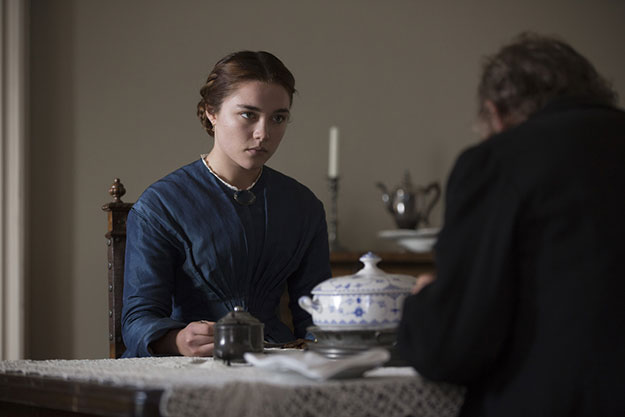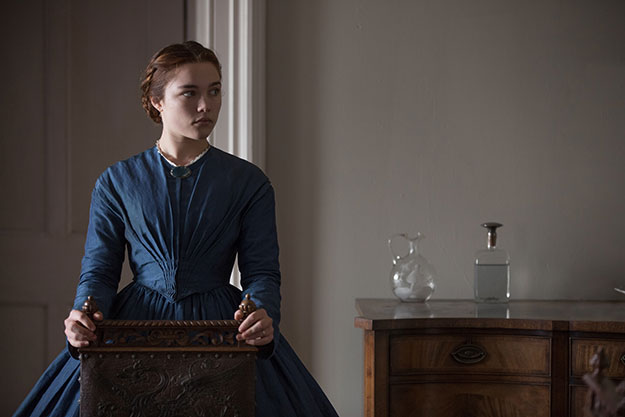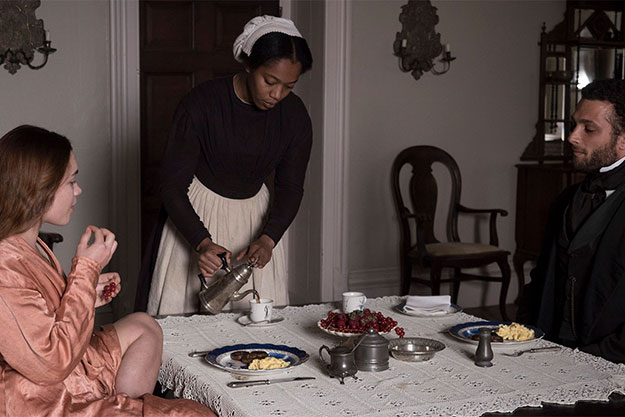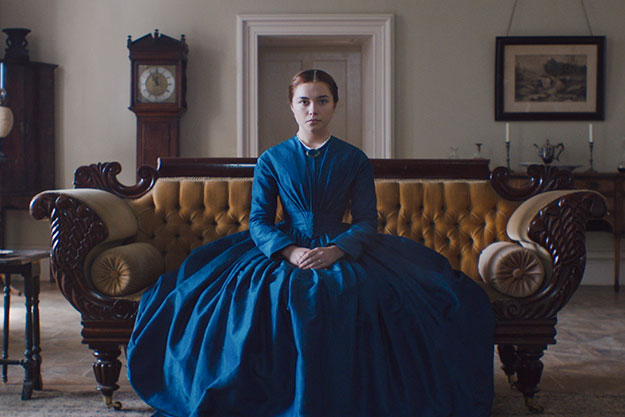Interview: William Oldroyd
In William Oldroyd’s steely depiction of 19th-century social repression, Lady Macbeth, confinement is conveyed through everyday rituals. Its teenage protagonist Katherine (Florence Pugh) is sold into a marriage that offers her nothing physically or emotionally, and lives in isolation in her middle-aged husband Alexander’s austere country house, with little to do except wait out each passing day. Her daily routines of waking up and bathing are rendered with such ferocity—the soundtrack amplifies every brushstroke as though shredding through knots in Katherine’s hair—that the film’s eventual escalation into physical violence and murder seems a natural progression. As Oldroyd put it during the interview: “Something as simple as somebody brushing somebody’s hair should be an act of violence without meaning it to be.” When Katherine begins an affair with a farmhand named Sebastian (Cosmo Jarvis), she actively rebels against the life that’s boxing her in, but as the body count rises, the film leverages a structural critique without flattening Katherine into an easy archetype.
Though Lady Macbeth viscerally depicts Katherine’s plight, the film maintains a distance between audience and character that might speak to Oldroyd’s interests as a theater director—he has staged Ibsen’s Ghosts as Director in Residence at the Young Vic in London and mounted productions of Beckett and Sartre around the world. Lady Macbeth is another exercise in adaptation for Oldroyd: it’s based on Nikolai Leskov’s 1865 novella Lady Macbeth of the Mtsensk District, which had previously been tackled cinematically by Andrzej Wajda, and, most notoriously, was adapted into an opera by Dmitri Shostakovich that was banned in the Soviet Union. As Oldroyd’s debut feature, it offered the director an on-the-ground education in the filmmaking process.
Film Comment met with Oldroyd after Lady Macbeth screened at New Directors/New Films in March to discuss the adaptation process, building the film’s contrasting rhythms, and the difficulties of stylistically emulating Béla Tarr.

How did you approach adapting the novella, and what was it like to develop the film with screenwriter Alice Birch, another theater veteran?
She brought me the novella and thought it would be an interesting story. I knew the opera, but I had never read the book. When I read it, I thought, “Yeah, this is great.” But the thing is, we were two people from theater who didn’t know the first thing about film, so when we met Fodhla [Cronin O’Reilly, the producer], she said, “Well, you’ve got to write a treatment.” So Alice wrote this one-sided outline, but it wasn’t a treatment. So we had to go through the whole story together. She said, “Look, why don’t you just close your eyes. You’ve read the book. Just tell me the story, as you imagine it, pictures and everything.” She jotted it down and then was able to incorporate whatever I saw in that moment into whatever she felt about it, and drew up a 15-page document. It was a representation of images, ideas, and specific scenes. That became the basis for our application to finance the film.
We were really, really clear when making the film that we weren’t interested in exposition. If we did need exposition, it would have to be put in there in a clever way that would not jump out. So we were very careful all the way through with things that would set up the scene. Also, because we’re both from theater, we were constantly saying to each other, “Is this cinematic enough to be in the film?” We were very nervous about making filmed theater, basically. So we were very good in that sense at keeping each other in check.
When you were drafting the treatment, which images from the novella came to you at first?
The way that the house is described. And some of the atrocities, like the abuse of Alexander [when a fight erupts after he returns to the estate]. I was really interested in trying to present on screen a young woman who has absolutely nothing to do. But how do you film boredom? Ultimately, you can’t go to financiers and say, “We thought we might film a woman doing nothing.” They’d say, “Oh god, there’s no one who’s going to want to watch that.” We had to find a clever way of representing that routine, that quite punishing hair-brushing and dressing and getting up, and making it a bit more active.
I was very interested in what it would be like for a young woman who’s full of life to be told that you’re now going to come into a situation where you have to put on restrictive clothing, go and sit on the sofa, literally just listen to your life ticking away, and you can’t have sex or kids because your husband won’t want to sleep with you, you can’t have any friends, there are no books, no piano to play, there’s no music, and you can’t go outside. These are all things that were sort of suggested in the book, but we wanted to focus on them more.
Could you talk about editing the film, and how you found those moments of dead air that you wanted to emphasize instead of clipping quickly through?
I really wanted to just watch a young woman fall asleep on a couch, but obviously that takes time, so we pushed it as far as we could. If you build the daily routine up at the beginning, it means that if you repeat that routine through the film, you can shortcut it somewhat, which was quite useful. So if you see Anna coming into the room, going over to the shutters, opening the shutters once… that means the next time you see it, you can see her open the door, and then you can cut directly to the shutters. Nick Emerson, our editor, cut David Mackenzie’s Starred Up. I loved that we could have the editor of a contemporary prison drama cutting our British period drama, because we hoped he would bring that sort of fresh energy and make it feel a bit more modern, which is what I wanted. I always trusted his instincts; he knew exactly when to cut.

You tend to let single-take, imbalanced two-shots evoke the characters’ power struggles. One moment that comes to mind is the dinner scene after Alexander’s father comes back, where he’s centered in the frame and Katherine is off-center—it’s a static shot, but her body language has a gravitational pull. Did your theatrical background inform how you staged these scenes?
For me, blocking always comes from the actor’s impulse to move. If I had the luxury of time and rehearsals, I wouldn’t tell the actors what to do, but I would set up a situation and then they would move accordingly. That’s actually not that common for [film] actors. The ones I’ve worked with in film expect me to tell them exactly where to move and where the camera’s going to be, but at first, I’d like to see what they want to do naturally, so they can give me some ideas to test. We had a week of rehearsals beforehand to just try out some scenes. It made it feel a bit more collaborative.
In theater, I would never just say, “Well, this is the blocking,” and expect the actors to listen, because it takes away their impulse, which I feel is very important. Whereas in film, you can say that, and the actor’s like, “Yeah,” and there’s none of the, “I’m not sure my character would do that.” People understand the time pressure. And they also trust you and think, “I can’t see what he’s seeing through the camera, so I’ll just go with it and do what he says in that moment.”
How did you move into directing film? You took a few film courses in college—was it something that you were always thinking about?
I was at art school when I first used a VHS camera, but it was for doing abstract work, not narrative. But it gave me access to this very basic editing facility, so I was cutting images together in an experimental movie, then re-filming it with mirrors and scratching it. It was quite strange, but at least it helped me to understand what happens when you put two images next to each other. Then I sort of left that and went and did theater for 10 years, and I talked with actors and writers, but felt like that experimentation with the camera was still lying dormant somewhere. I directed a play by Howard Barker [Scenes from an Execution] and then he wrote a new play whose first scene felt like a really nice little scene from a film. So I asked him if I could film it as a short film. When I shot it, it felt like watching filmed theater. So that began a whole process of me teaching myself what cinema was—reading books, talking to filmmakers, watching films I really liked and breaking them down, and trying to understand why the camera was in a certain position and what it was achieving.
What kinds of films were you watching?
There was one bit that was really handy from Fellini’s And the Ship Sails On. I watched it because I really like Pina Bausch, and she’s in it. We knew the sea was fake; we knew it was a plastic sheet. But still, you go with it. Then, at the end, he pulls back the camera and you see all of the crew. This is stuff we’d been doing with Brecht in the theater. So I was like, “Oh right, you can be theatrical in film!” I did some experiments with friends in the theater, and realized that the language was probably the problem. The engine was different. When you’re doing a play, a scene usually resolves, and then a new scene begins. The language is the thing that drives it. Whereas in cinema, you can cut away and come back to it, and the thought will transfer between moments. You have to capture thought rather than spoken word, more or less.
I watched so many films, like the work of [Michael] Haneke. I think Funny Games is quite theatrical. The mischief, in terms of playing with an audience’s expectations, and the trickery. Taking a remote control, pausing the film, and then rewinding it. This was breaking the fourth wall massively. Or playing with an expectation. Those antagonists in Funny Games, for me, seem as if they were taken from Waiting for Godot. It felt like they were two clowns in that tradition. And The Seventh Continent could be a play. It’s just set in one house where you see a family systematically destroying everything. I felt like this was somebody who was a really useful artist in terms of crossover, so I broke his films down. I must have watched them hundreds of times because I really wanted to know how he was making them.
Béla Tarr is someone else I really love. Werckmeister Harmonies feels very theatrical. But when I tried to make stuff in his style, it felt empty. I said, “Well, I’m not Béla Tarr.” I thought, I’ve just done a 10-minute short. It’s in black and white. Why does it feel totally empty? Because you’re just copying somebody! [Laughs] But these are very important experiments. So then you can say, “Okay, good, I now know I’m not Béla Tarr and never will be. I’ll move on and do something else.”

I wanted to ask about specific changes you made to the novella, particularly the addition of the housemaid Anna, who’s so important in how you structure the power dynamics of the film.
Anna is partly Alice’s invention, because she is the amalgamation of two characters in the book. There is a cook who gets weighed like a pig [in a menacing prank in the stables], and then there is a character called Sophia at the end—an ending that we cut—who Sebastian starts to fall in love with, which makes Katherine jealous. So we used both of those elements. We used Anna as the girl who gets weighed by Sebastian, and then we also built in, quite subtly, I have to admit, Sebastian following Anna when he’s lonely at the end, and then that indirectly making Katherine jealous and pushing their relationship a bit further. So ultimately, Katherine doesn’t feel so bad about condemning Anna, since she feels like she has betrayed her.
Really, the way Alice sees it is that Anna and Katherine sort of come from the same background. They both enter the house as servants: Katherine as a servant to the bedroom, Anna as a servant to the kitchen and to the house. Katherine is jealous of the freedom Anna has, that she can go outside, she can make friends, and so on.
And there’s the way that Katherine wields her power over her, too, in pivotal scenes.
I think part of it is that she’s growing up in a house where violence is all around her. If you noticed, she starts to adopt the language of the men. She walks into the barn and says, like her husband, “Turn around and face the wall. Stop smiling.” These are words that she’s heard. So I can forgive Katherine in a way … She may not be totally aware of what she’s doing, but she’s harsh because she thinks, “That’s the part I have to play.” It is interesting that she doesn’t find a confidante in Anna. But Katherine is a complex character.
It’s more about being trapped in these repressive structures, which, in a way, she still hasn’t totally escaped when she’s alone at the end.
That’s the irony of the movie. She’s free of all of those things that she was trapped by at the beginning, but she’s not free at all. We worked quite hard to get that balance.
You’ve mentioned that 19th-century Danish paintings inspired the look of the film—what else influenced your aesthetic approach to the shot compositions, and the contrasts in color and light?
The paintings were something I had known from doing Ibsen in the theater, since a lot of people use the Danish artist Vilhelm Hammershøi as a design reference for Ibsen. So Jacqueline [Abrahams], our production designer, and I went through his book. The paintings worked very well with the light that was coming into [our set for] Katherine’s house naturally anyway, and the fact that our house was empty, so that we could just put a couple of pieces of furniture into these empty rooms and keep it quite sparse. What we found on location was barren—just a big empty castle in Durham county, which is in northeastern England. I went to Durham University, so I knew that area. This castle is the family seat of the Earl of Durham, Lambton Castle. We were very lucky to have it, because there’s a river by it, there are forests, and we could shoot a lot of our exteriors around the castle, and then we could also move in our production office and unit base. We basically had a small studio in this castle, which was ideal. That also meant we could shoot chronologically. But quite a lot of British Victorian period dramas use heavy drapes and dark woods and stuff it with clutter. We wanted to try and create a vacuum, an airless environment that was light and bright, and we wanted to make that feel stifling rather than closing it down and making it dark.
How did you go about constructing the sound design? I’m interested in your choice to synthesize sound effects from prison doors into new cues.
We just tried it out. This is where you have the luxury of time in the post. I didn’t realize how much of a film is basically made in sound. But now, as a storytelling tool, I see that it’s crucial. You may not be aware of it, but when the wooden shutters are opening, there is a metallic sound being used. And a little bit of reverb on the door clanging, and some reverb on the shoes. I think it triggers, in the subconscious, a world that we recognize from other films. That was the idea, without making it too literal or heavy-handed. But we really wanted to create a sense of that routine being tortuous rather than just irritating. It should actually be oppressive, and something as simple as somebody brushing somebody’s hair should be an act of violence without meaning it to be, or scrubbing something in the bath.
I love the moment—probably the loudest moment in the film—when we’ve just had a period of maybe five or six minutes of Anna and Alexander sitting and drinking tea, just talking. Then suddenly, it all explodes, and you’ve got somebody biting somebody’s neck, and there’s blood-curdling screams, and then the sound of the poker. And afterward, it’s quiet again. I like playing with contrasts. I think it’s nice to have that strong dynamic.

The sudden bursts of sound and explosive violence are so forceful as a contrast to the quietude, but they aren’t mutually exclusive—the suffocation scene at the end is a moment of unsettling quiet. How did you choreograph that take?
I shot that all in one because I thought, if the audience wanted to look away, they’d have to look away from the screen. If I cut, that might relieve the tension somehow. I also wanted to treat all of the deaths differently. So the first one is off-screen, and I like that because it’s theatrical. You can imagine what’s happening through the soundtrack. Alexander’s death is a surprise, so it should feel like a surprise, and a little bit of a shock. With [Alexander’s child ward] Teddy, I wanted it to feel excruciating, as it should, and therefore you should have to look away from the screen if you don’t want to see it.
Anton [Palmer, who plays Teddy] didn’t know what we were doing. I don’t mean that we actually suffocated him without telling him. I was sitting next to his mum. But you can’t say to a 6-year-old, “Can you play dead?” because he won’t understand what you mean. You can’t say to him, “Can you lie down and pretend to be asleep?” because then he’ll do a sort of comic snoring. But you can say to a 6-year-old who’s very competitive, “I bet you can’t lie still, close your eyes, and count to 100 in your head.” And he’ll say, “No, I can.” We broke the scene down into games for him to play, and then ultimately, the cumulative effect is what you see.
When you make something like that really technical—like the fight with Alexander, we broke that down, shot-by-shot, going around the room—when you edit it together, it looks great, very fluid and organic. But it was really, almost irritatingly, precise and mechanical! I’m not used to that. In theater, they would have a fight, and it would be the moment in real time. But because we broke down Teddy’s death and made it very technical and mechanical, it took the emotion out of it. So it was only afterwards, when you when you put the muffling sound effects in with ADR—that’s when the power of it comes through. But on the day, it wasn’t so harrowing to make. We said, at one point, “Do we need to get close-ups?” But we knew we wanted to do it in one shot, and if we got the coverage, there would be the temptation in the edit to use it. I probably will never, ever have an opportunity to do that ever again. I will probably be told in the future, “No, you will get this coverage!” That’s the joy of independent filmmaking.



